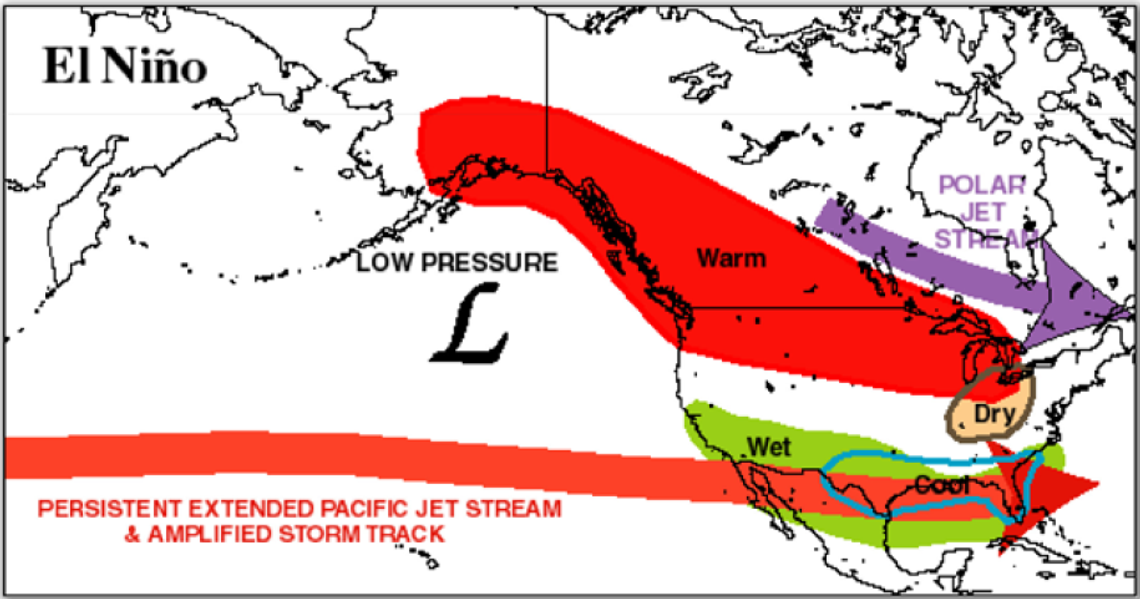Weather is one of my favorite subjects. As we go into spring, we won- der what to expect. One thing that can help us to predict the weather and plan our daily activities, is to learn about the different weather cycles El Niño and La Niña are opposite phases of what is known as the El
-Southern Oscillation Cycle. El Niño is sometimes referred to as the warm phase, and La Niña is sometimes re- ferred to as the cold phase.
El Niño means the little boy, or Christ child in Spanish. El Niño was original- ly recognized by fisherman of the coast of South America in the 1600s with the appearance of unusually warm water in the Pacific Ocean. This was important to them, because of the warm water, they did not catch many fish. The name was chosen based on the time of the year (around December) during which these warm water events occurred.
The term El Niño refers to the large- scale ocean atmosphere climate interac- tion linked to periodic warming in sea surface temperatures, across the central and east-central Pacific
Typical El Niño effects are likely to develop over North America during winter season. Those include warm- er-than-normal-average temperatures over the western and northern United States. Wetter-than-average conditions are likely over portions of the U.S Coast and Florida.
Dryer-than-normal average conditions can be expected over the Pa- cific Northwest and Ohio Valley region. La Niña means little girl in Spanish. It is sometimes called "A Cold Event." El Niño and La Niña behave like a brother and sister. Like a lot of siblings, they are opposite in every way. La Niña causes water in the eastern Pacific to be colder than usual. In the same region, El Niño can cause water to be warmer than usu- al. Areas that are hard hit with drought during La Niña years are pummeled with rain in El Niño years. A La Niña year usually happens a year or two after an El Niño year. Scientists now do not think that a La Niña is always caused by an El Niño.
La Niña is a weather pattern that oc- curs in the Pacific Ocean every few years. In this pattern, winds along the equator push water westward. Warm water from the ocean’s surface blow from South America toward Indonesia. As the warm water moves west, cold water from the deep part of the ocean rises up to the surface. The cold water ends up off the coast of South America. Rain clouds usually form over warm ocean water. La Niña blows most of this warm water to the western Pacific. Because of this, places like Indonesia and Australia get much more rain than usual. The cold water in the eastern Pacific causes less rain clouds to form over- head. So, places like the southeastern U.S. can be much dryer than usual. Even though La Niña is caused by an interaction between the Pacific Ocean and the atmosphere above, it can have large effects on weather all over the world. These changes in the atmo- sphere can lead to more lightning activity around the Gulf of Mexico area and along the Gulf Coast. Also, the environmental conditions during La Niña can lead to more hurricanes or cyclones forming.
According to the National Weather Ser- vice, we are in a Transition or Neutral Period between El Niño and La Niña. We are entering a La Niña Pattern. Near normal to above normal rainfall with afternoon thunderstorms is expected for the next few months. The temperature will be normal to slightly warmer than normal.
We just came off two major weath- er events, or six days of ice, snow and sleet. We have seen the effects of these storms, broken limbs, car accidents, businesses and offices closed, dead and sick livestock, emergency rooms full of folks injured from falls, and a municipal water shortage. We know who controls the weather, and it’s certainly not us.
Sources: NOAA SciJinks, "All About Weather," NOAA Climate Predication CenterNCEP/NWS

By Doug Carter, Rankin County Extension Agent
Special to Pelahatchie News


Comment
Comments